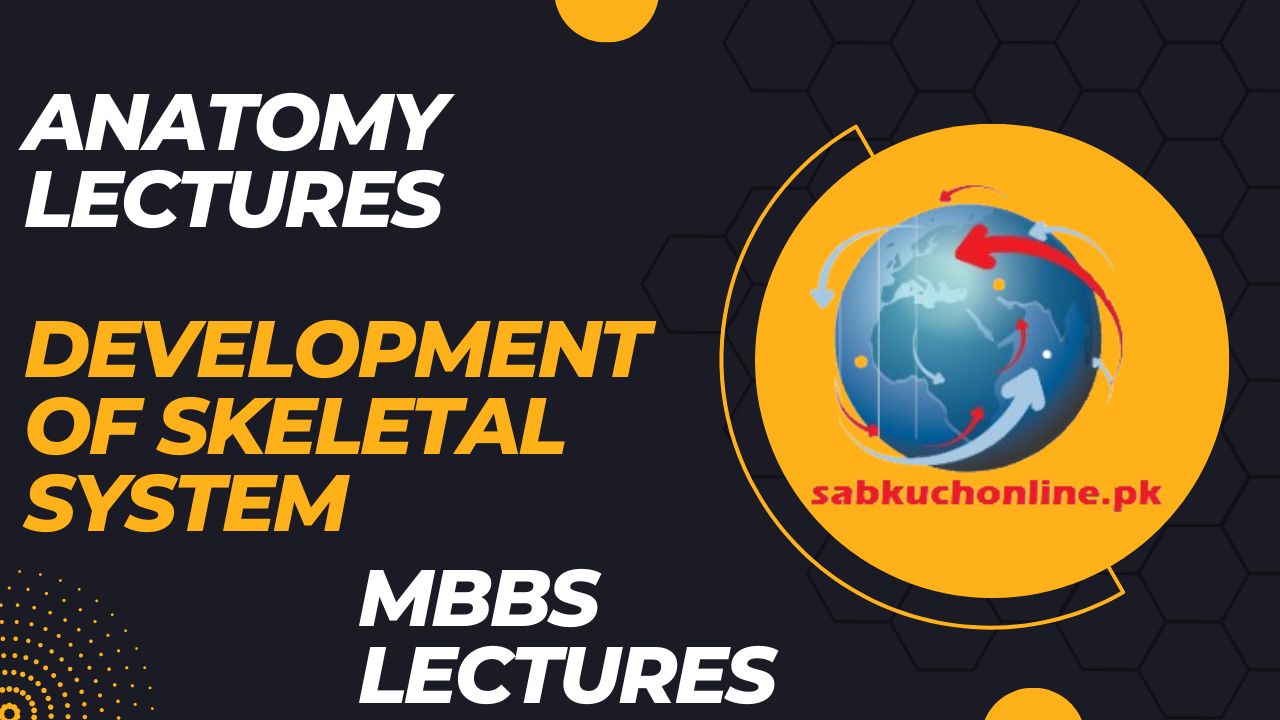LEARNING OBJECTIVES
- Identify the sources of origin of skeletal system.
- Revisit the parts and derivatives of a somite.
- Describe the normal development of vertebral column with emphasis on mesenchymal, cartilaginous and bony stages of development, with special focus on the process of resegmentation.
- Describe the development of ribs and sternum.
- Define spina bifida.
- Distinguish various types of spina bifida on embryological basis
- Appraise prenatal prevention and prenatal diagnosis of spina bifida.
- Explain embryological basis of accessory ribs, variation in number of vertebrae, abnormal vertebral curvatures and sternal anomalies.
Develops from:
- Paraxial Mesoderm
Somitomeres (head region)
Somites (occipital region — caudally)
Sclerotome →mesenchyme →Fibroblasts
→Chondroblast →Osteoblast
Dermamyotome → Dermis & muscle
Occipital somites and somitomeres → cranial vault & base of skull
- Lateral plate Mesoderm (somatic)
Pelvic & Shoulder girdles
Long bones of limbs
- Neural crest cells→ mesenchyme → Face & skull bones
DEVELOPMENT OF SKELETAL SYSTEM


DEVELOPMENT OF BONE AND CARTILAGE
- Bones first appear as condensations of mesenchymal cells that form bone models. .
- Most flat bones develop in mesenchyme within pre-existing membranous sheaths, this type of osteogenesis is intramembranous bone formation.
- Mesenchymal models of most limb bones are transformed into cartilage bone models which later become ossified by endochondral bone formation..

HISTOGENESIS OF CARTILAGE
- Cartilage develops from mesenchyme and first appears in embryos during the fifth week.
- The mesenchyme condenses to form chondrification centers.
- Chondroblasts (cartilage forming cells) secrete collagenous fibrils and the ground substance of the matrix.
- Subsequently, collagenous and / or elastic fibers are deposited in the intracellular substance.
HISTOGENESIS OF BONE
- Bone develops in two types of connective tissue, mesenchyme and cartilage.
- Bone consists of cells and an organic intercellular substance, the bone matrix that comprises collagen fibrils embedded in an amorphous component.
DEVELOPMENT OF JOINTS
- Joints begin to develop during the sixth week and by the end of the eighth week, they resemble adult joints.

DEVELOPMENT OF SKELETON
- The axial system is composed of:
- Cranium (skull)
- Vertebral column
- Ribs
- Sternum
- The appendicular skeleton is formed of pelvic & shoulder girdles & limbs
VERTEBRAE & THE VERTEBRAL COLUMN
- Vertebrae form from the sclerotome portions of the somites, which are derived from paraxial mesoderm.

VERTEBRAL FORMATION
- A typical vertebra consists of
- Vertebral arch
- Foramen
- Body
- Transverse process
- Spinous process

VERTEBRAL FORMATION
- During the 4th week, sclerotome cells migrate around the spinal cord & notochord to merge with cells from the opposing somite on the other side of the neural tube.



RESEGMENTATION
- As development continues, the sclerotome portion of each somite also undergoes a process called resegmentation.
- Resegmentation occurs when the caudal half of each sclerotome grows into & fuses with the cephalic half of each subjacent sclerotome.
- Thus, each vertebra is formed from the combination of the caudal half of one somite and the cranial half of its neighbour.
Notochord regresses entirely in the region of vertebral bodies, it persists & enlarges in the region of the intervertebral disc.
- Intervertebral disc: Consists of the:
- Nucleus pulposus (remnant of the notochord) and
- Annulus fibrosus (outer rim of fibro-cartilage, derived from mesoderm/sclerotome).




MUSCLES OF THE VERTEBRAL COLUMN
- Resegmentation of the sclerotome into definitive vertebrae causes the myotomes to bridge the intervertebral discs, & this alteration gives them the capacity to move the spine.
- For the same reason, intersegmental arteries, at first lying between the sclerotomes, now pass midway over the vertebral bodies.


- Spinal nerves come to lie near the intervertebral discs and leave the vertebral column through the intervertebral foramina.

SPINA BIFIDA

SITE OF SPINA BIFIDA OCCLUTA
A child with a hairy patch in the lumbosacral region indicating the site of spina bifida occluta

SPINA BIFIDA WITH MENINGOMYELOCELE IN THE LUMBER REGION




HEMIVERTEBRA
- Failure of one of the chondrification centers to appear
- Subsequent failure of half of the vertebra to form
- Produces scoliosis

SCOLIOSIS

DEVELOPMENT OF RIBS
- From costal process of the thoracic vertebra
- Derived from sclerotome portion of the paraxial mesoderm




CERVICAL & FORKED RIBS

ANOMALIES OF THE STERNUM
- Pesexcavatum is the most common thoracic wall defect. A concave depression is present in the lower sternum which is due to the overgrowth of costal cartilages.

CLEFT STERNUM


DEVELOPMENT OF APPENDICULAR SKELETON
- The appendicular skeleton consists of the pectoral and pelvic girdles and the limb bones.
- Mesenchymal bones form during the fifth week as condensations of mesenchyme appear in the limb buds.
- During the sixth week, the mesenchymal bone models in the limbs undergo chondrification to form hyaline cartilage bone models.


- Ossification begins in the diaphyses of long bones from primary centers of ossification.
- By 12 weeks, primary ossification centers have appeared in nearly all bones of the limbs.
- The clavicles begin to ossify before any other bones in the body.

- The femora are the next bones to show traces of ossification.
- Most of the primary centers appear between the 7th to 12th weeks of development.
- Virtually, all primary centers of ossification centers are present at birth.
- The part of a bone ossified from a primary center is the diaphysis.
